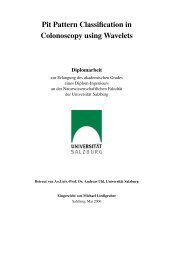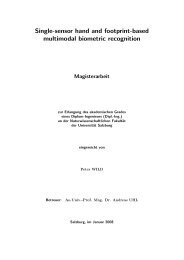A Survey of H.264 AVC/SVC Encryption
A Survey of H.264 AVC/SVC Encryption
A Survey of H.264 AVC/SVC Encryption
You also want an ePaper? Increase the reach of your titles
YUMPU automatically turns print PDFs into web optimized ePapers that Google loves.
4ciphertext. If one considers the raw video data as plaintextsthe preservation <strong>of</strong> any information, even the preservation <strong>of</strong>the length <strong>of</strong> the compressed video stream or the length <strong>of</strong>units that comprise the compressed video stream constitutes asecurity violation, as even the compressibility <strong>of</strong> the raw videodata leaks information on the raw video data. If encryption isconducted after compression the compressibility informationis contained in the length <strong>of</strong> the compressed video data. Thissecurity notion appropriately models the security requirements<strong>of</strong> highly confidential video communications, e.g., video conferencesin politics and economy. Thus in this very strictinterpretation <strong>of</strong> MP-security for video cryptosystems (the rawvideo data is the plaintext space), the length <strong>of</strong> the video data(or packets) must not depend on the raw video data itself. Thishas major implications for the compression settings and videopacketization, e.g., in a video conferencing or VoD scenario.In order to ensure that absolutely no information about thevisual content is computable from the transmitted encryptedand compressed video data, even the length <strong>of</strong> the packetsmust not depend on the raw video data [19]. This impliesthat for this interpretation <strong>of</strong> MP-security the video has to betransmitted at a source-independent rate (e.g., constant) and ina source-independent fashion (e.g., constant packet lengths).The issue that video streams can be identified is present evenin “secure” state-<strong>of</strong>-the-art technology, e.g., in SRTP [19] andIPsec, as the secure encryption <strong>of</strong> packets does not concealthe packet lengths. This strict security notion, which we referto as MPV-security, for video cryptosystems conflicts withrate-distortion optimal packetization and an optimal secureadaption, also referred to as secure scalable streaming (SSS) inthe context <strong>of</strong> network adaptation [4], [3]. MPV-security doesnot at all model the security requirements and threats <strong>of</strong> manyapplication scenarios at all, e.g., <strong>of</strong> perceptual / transparentencryption and privacy preserving video surveillance.The preservation <strong>of</strong> format-compliance could be assumedto compromise security, recent contributions from the cryptographiccommunity [6] discuss the topic in depth anddefine a concise formal framework and re-formulate the MPsecuritynotion for format-preserving encryption (MP-securityis defined for equal length format-compliant datums) and alsoanalyze format-preserving encryption algorithms, which areproved to be secure. However, there still is a gap between thetheoretic availability and the practical applicability <strong>of</strong> formatpreservingand secure encryption algorithms [60] and thissecurity notion is also not applicable for many applicationscenarios in the context <strong>of</strong> multimedia encryption.Lightweight / S<strong>of</strong>t / Partial / Selective <strong>Encryption</strong>: Somecontributions to multimedia encryption propose the application<strong>of</strong> less secure but more efficient encryption algorithms (s<strong>of</strong>tencryption), i.e., the computational complexity to break theemployed cryptosystem with respect to MP-security is limited.E.g., in [16] it is proposed to employ a weaker cipher (an AESderivative with fewer rounds) for the less important parts <strong>of</strong> thebitstream. Often obviously insecure algorithms are employed(e.g., adding constants to the coefficients [31]) which also fallinto that category.Another approach to reduce the computational complexity<strong>of</strong> encryption is selective / partial encryption <strong>of</strong> the bitstreamwith a secure cipher [46].In this paper, we will discuss the schemes in a cipherindependentfashion, i.e., all encryption proposals will beconsidered to employ the same secure cipher as single source<strong>of</strong> pseudo-randomness.B. Preserved Functionality<strong>H.264</strong> bitstreams are associated with functionalities, i.e.,there are specified protocols and processes how to store, transmit,and process <strong>H.264</strong> bitstreams (e.g., extract parts, adaptthe rate, . . .). Non-scalable and scalable <strong>H.264</strong> bitstreams areaccessible via a network abstraction layer (NAL), i.e., thecoded video data is a sequence <strong>of</strong> separate NAL units (seefigure 3 for a possible mapping <strong>of</strong> raw video data to NALunits).<strong>H.264</strong> bitstreams are embedded into container formats fortransmission and storage [72], [25] and depending on theencoding settings bitstreams allow certain operations, suchas extraction <strong>of</strong> IDR-picture (comparable to an I-frame inprevious standards), extraction <strong>of</strong> a subset <strong>of</strong> the frames,cropping and in the case <strong>of</strong> <strong>SVC</strong> the extraction <strong>of</strong> sub-streamswith different spatial resolution, temporal resolution and SNRquality.A wide range <strong>of</strong> watermarking algorithms specificallytailored to <strong>H.264</strong> have been proposed, e.g., [38], [50], [24],[80], [79], [47] and a joint application <strong>of</strong> encryption andwatermarking, especially watermarking encrypted content, is<strong>of</strong>ten desirable [38], [10], [80], [79].1) Format-compliance: A bitstream is denoted formatcompliantor <strong>H.264</strong>-compliant, if it suffices the syntax’sand semantics’s requirements <strong>of</strong> the <strong>H.264</strong> standard [27].A format-compliant <strong>H.264</strong> bitstream has to be accepted byevery <strong>H.264</strong>-compliant decoder without any undefined decoderbehaviour. It is necessary to distinguish whether afunctionality is preserved format-compliantly, i.e., standardprocessing can be applied and no modified s<strong>of</strong>tware is necessary.E.g., functionality is not preserved if the encryptedparts <strong>of</strong> the video are signalled as supplementary data, whichhas no semantics in the <strong>H.264</strong> decoding process comparableto commentary in programming languages. The encrypted<strong>H.264</strong> bitstreams where the encrypted data is signalled assupplementary data (e.g., using SEI messages, see table I)are still format-compliant, but the encrypted video data istreated completely different compared to plaintext video data.Thus the application <strong>of</strong> conventional tools to process thevideo data may lead to unexpected and undesired behaviour,e.g., rate adaptation algorithms may not perform optimal onthe encrypted bitstreams. Thus we say that a functionality ispreserved in a compliant fashion, if exactly the same processesas for an <strong>H.264</strong> bitstream are applicable.2) Packetization: NAL syntax / structure: The preservation<strong>of</strong> the NAL structure and syntax requirements enables thetransparent application <strong>of</strong> standard container formats and toolsfor <strong>H.264</strong>.3) Fast Forward / Extraction <strong>of</strong> Subsequences / Scalability:NAL semantics: The additional preservation <strong>of</strong> the NALsemantics, i.e., the NAL unit type (NUT, see figure 4) enablesmore sophisticated processing <strong>of</strong> the encrypted bitstream, such








